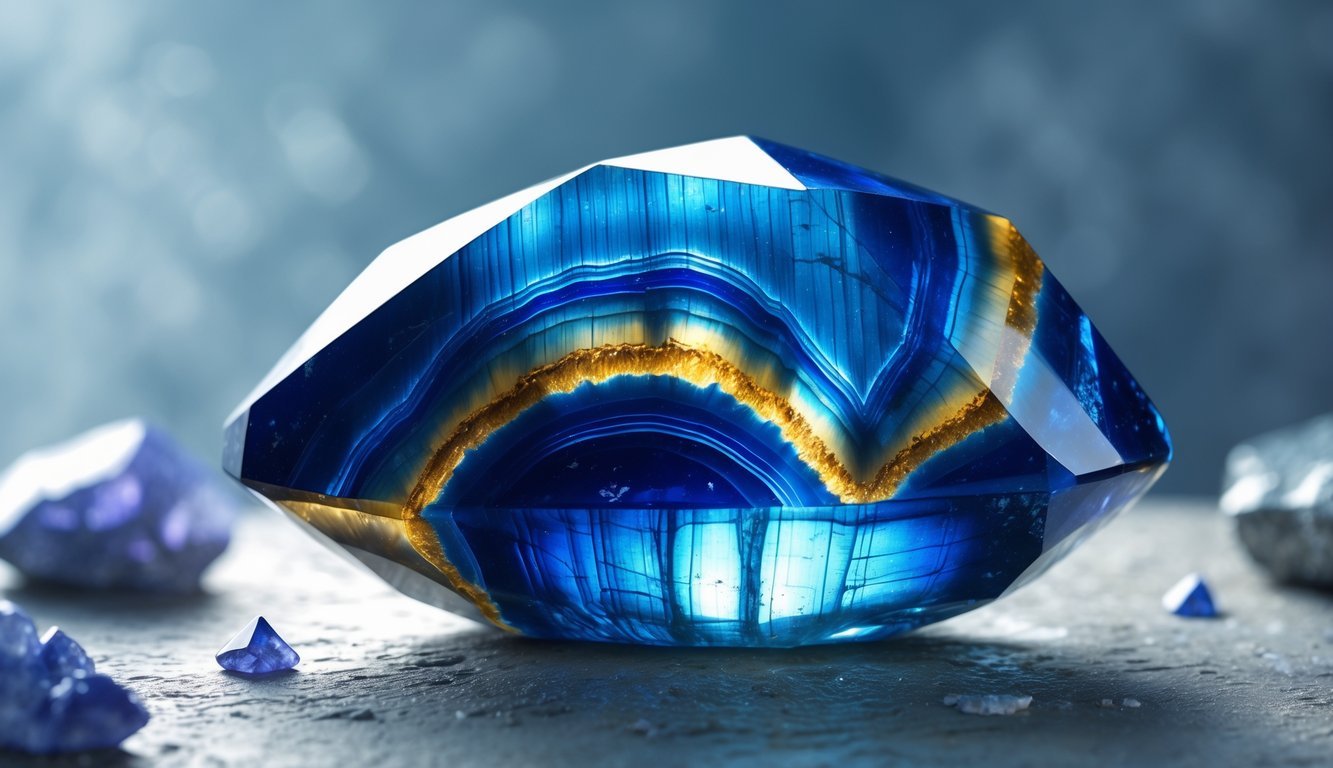PsychNewsDaily Publishers
100 Summit Drive
Burlington, MA, 01803
Telephone: (320) 349-2484
PsychNewsDaily Publishers
100 Summit Drive
Burlington, MA, 01803
Telephone: (320) 349-2484
Blue Tiger's Eye is a gemstone known for its striking blue color, promoting strength, courage, and mental clarity. It features a silky chatoyant effect and forms from crocidolite.

Blue Tiger’s Eye stands out as a gemstone, thanks to its striking blue color and the meanings people attach to it.
Many believe it brings strength, courage, and sharper thinking to anyone who wears or carries it.
This stone forms when blue crocidolite fibers get replaced by silica. That process gives it a smooth, silky appearance that a lot of folks find calming and even a bit inspiring.
People sometimes call it “Hawk’s Eye” when it’s naturally blue. Most stones sold as Blue Tiger’s Eye, though, get their color from dye.
Collectors and crystal fans use this stone for its looks and its energy. It might help you feel more focused and confident, especially when life gets tough.
If you’re curious about what makes Blue Tiger’s Eye special or wonder how it could help you, stick around. We’ll explore where it comes from, what it means, and how people use it—then you can decide if it belongs in your collection or daily routine.

Blue Tiger’s Eye has some pretty unique physical traits and a cool backstory. Its color and shine set it apart from the usual Tiger’s Eye stones.
Let’s look at what gives it its vibe, where it shows up, and how you can tell it apart from other stones.
Blue Tiger’s Eye starts as blue crocidolite, which slowly turns into quartz over a long time. That process keeps the blue color but gives the stone the toughness of quartz.
It scores about 6.5 to 7 on the Mohs hardness scale, making it sturdy enough for jewelry.
The stone shows off a shimmering, light-reflecting effect called chatoyancy. That’s the silky, moving shine you’ll see—one reason people call it Hawk’s Eye or Falcon’s Eye.
You’ll notice its smooth feel and deep blue to bluish-gray colors. That’s a big contrast to the golden or red shades in other Tiger’s Eye stones.
Blue Tiger’s Eye forms in spots where crocidolite (a blue asbestos mineral) exists. Over time, quartz replaces the crocidolite, turning it into the gemstone you see.
South Africa and Namibia are the main sources, thanks to their rich crocidolite deposits. You can also find it in India, Canada, Australia, and Brazil, but it’s less common there.
This stone forms deep underground where the right minerals and conditions meet up. The slow replacement from crocidolite to quartz keeps the stone strong and beautiful.
To spot Blue Tiger’s Eye, check out its color and shine. This stone has blue and gray tones, while Gold Tiger’s Eye looks yellow-brown and Red Tiger’s Eye has reddish hues.
The chatoyant shine of Blue Tiger’s Eye is usually brighter and cooler compared to the others. That’s why some call it Hawk’s Eye or Falcon’s Eye.
Make sure you’re getting a natural stone. Natural Blue Tiger’s Eye has a silky shine and smooth texture. If it looks too flat or the color’s too even, it might be dyed or fake.
| Type of Tiger’s Eye | Color Range | Common Names | Chatoyancy Color |
|---|---|---|---|
| Blue Tiger’s Eye | Blue to bluish-gray | Hawk’s Eye, Falcon’s Eye | Bright, blue shimmer |
| Gold Tiger’s Eye | Yellow to golden brown | Tiger’s Eye | Warm, golden shine |
| Red Tiger’s Eye | Red to reddish brown | N/A | Warm, red shimmer |

Blue Tiger’s Eye blends calming energy with mental clarity. Lots of people say it helps them feel more balanced, confident, and safe.
It’s also said to support creativity, communication, and healing in plenty of ways.
If you’re dealing with anxiety or stress, Blue Tiger’s Eye might help you feel more grounded. It acts as a calming stone that steadies your emotions when things get rough.
Holding or wearing this stone can help you let go of fears and negative thoughts. You may find it brings a sense of peace and more balance to your daily life.
Blue Tiger’s Eye connects most with the Third Eye and Throat chakras. These are the energy centers for intuition and communication.
Wearing it can sharpen your insight and help you speak your mind clearly. During meditation, it might deepen psychic abilities and boost your inner vision.
You could notice more awareness of subtle energies or find it easier to trust your gut. This connection also encourages spiritual growth and mental focus.
Blue Tiger’s Eye acts as a protective stone, shielding you from negative vibes and harm. It’s like a talisman, helping you feel safe and grounded.
People use it to guard against the “evil eye” and other bad influences. It’s also known for boosting confidence and willpower, so you can tackle challenges with courage.
Many believe it attracts good luck and abundance. Some folks say they feel stronger and more open to new opportunities when they keep it close.
Blue Tiger’s Eye can help you get your point across by promoting clear thinking and honest expression. It often helps people find the right words, which is handy for teamwork or public speaking.
This crystal can also spark creativity by clearing mental blocks and encouraging new ideas. It helps you link wisdom with creativity, so problem-solving gets easier.
It’s common to notice sharper focus and mental clarity when you use this stone regularly.
Blue Tiger’s Eye supports both physical and emotional health. Some believe it helps balance blood pressure and boosts energy, which supports overall wellness.
Emotionally, it calms anxiety and can lift your mood. It’s said to promote healing by reducing stress, which has positive effects on your body.
It also encourages self-confidence, which matters for bouncing back from emotional setbacks. You can use it as a comfort during tough times for a little extra stability.
Blue Tiger’s Eye has a long history. Ancient Egyptian soldiers wore it for protection in battle, connecting it to the power of the sun god Ra.
Roman soldiers carried it as a talisman for courage and strength. Over time, people saw it as a stone of good fortune and spiritual insight.
Its unique color and mystical properties have always made it appealing. That history adds to its reputation as a meaningful and powerful amulet even now.
You can wear Blue Tiger’s Eye as a necklace, ring, or bracelet to keep its energy close all day. It works well in jewelry since it’s durable and has eye-catching blue and gray bands.
To care for it, cleanse the stone with water or sage smoke to clear away negative energy. Avoid harsh chemicals and keep it out of strong sunlight to maintain its shine.
Wearing it daily or using it during meditation helps you enjoy its calming and protective effects.

Blue Tiger’s Eye brings practical and spiritual benefits. Knowing its meaning, how to spot the real thing, and how to use it helps you get the most out of your stone.
Wearing Blue Tiger’s Eye can sharpen your focus and intuition. Many people say it calms them and helps with decision-making.
It also supports spiritual growth and vision.
Blue Tiger’s Eye stands for protection and mental strength. It represents calmness, insight, and balance.
It helps connect your mind and spirit, especially during meditation or tough times.
Blue Tiger’s Eye mainly connects to the throat chakra. This helps with clear communication and expressing your true thoughts.
It can also link to the third eye chakra for better intuition.
Blue Tiger’s Eye, or Hawk’s Eye, shows a blue-gray shimmer. Regular Tiger’s Eye is golden brown with a silky shine.
Natural stones feel heavier than fakes or dyed ones.
Don’t wear Blue Tiger’s Eye during sports or heavy work—it can chip or break. Always check if your stone is dyed or natural; natural stones usually feel heavier and look a bit different than dyed ones.
Keep your Blue Tiger’s Eye somewhere you’ll notice it often—maybe as a bracelet, or just tucked in your pocket. When you meditate, try holding it in your hand, or set it gently on your throat or third eye.
Some people say it helps them focus or feel more connected spiritually. Why not give it a shot and see if it works for you?